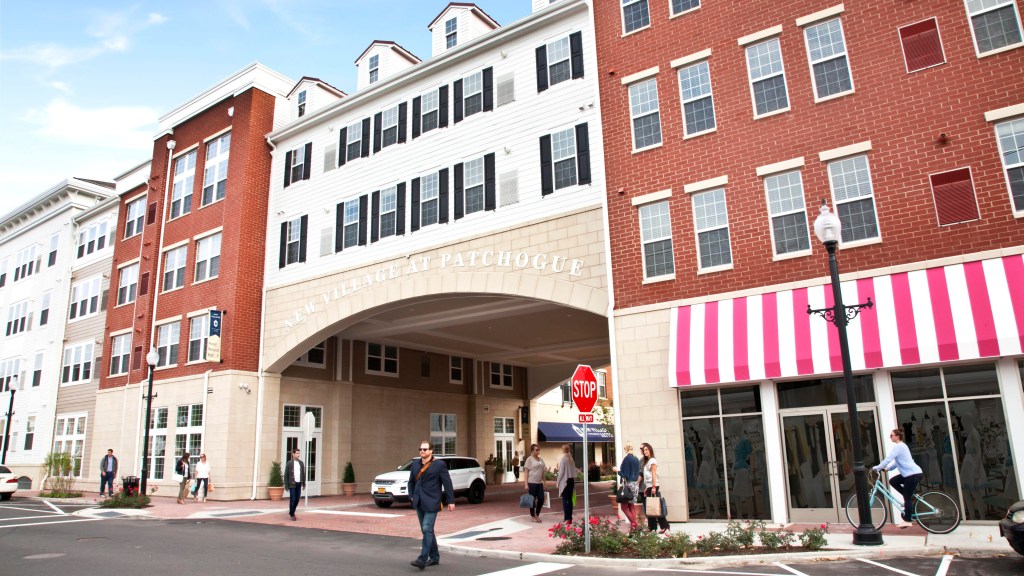Millennials. The Brain Drain. Jobs. What do these terms all have in common?
Apparently, the connection is multifamily housing. According to proponents, multifamily housing will allow Long Island to retain its millennials, who are reportedly fleeing in droves, aka the Brain Drain, and developing mixed-use multifamily housing will generate jobs.
Is this type of development the solution to our region’s economic malaise? Yes, and no—depending on where they crop up.
The theory is that multifamily housing, placed within a “walkable” distance from the Long Isand Rail Road station, is the best way to reinvigorate Long Island’s burned-out villages and downtown areas. Transit-oriented development (or TOD for short) is rooted in a relatively new kind of urbanism that calls for “Smart Growth” to cure the ills of suburban sprawl. Much of our clogged traffic, high property taxes and lack of job opportunities stems from the fact that we all live in our own separate piece of paradise. Increasing Long Island’s population density, the measure of people per square mile, will cure the suburban sickness that ails us.
For far too long, Long Islander builders have focused on supplying single family homes, but the tide has turned. Suddenly, it seems that both stakeholders and developers are united in saying that Long Island needs more apartments, in other words multifamily housing. So, like any responsive capitalistic endeavor, that’s what developers have started to build. Certainly, compared to our neighbors, Long Island has the lowest supply of apartments in the metropolitan area outside of New York City.
According to U.S. census data, 21 percent of Long Island’s households live in rentals, compared with 33 percent in western Connecticut, 34 percent in the Hudson Valley, and 37 percent in northern New Jersey.
Various stakeholder groups like the Suburban Millennial Institute, which recently held a conference at Hofstra University dedicated to the creation of jobs on the Island for this younger generation; Destination Long Island, a nonprofit organization that pushes for “triple-bottom-line economic development”; and other advocates have embraced this statistical shortfall, regularly pushing for the creation of more apartments Island-wide. As Suburban Millennial Institute’s founder, Jeffrey Guillot, put it, “I’m happy to join the chorus of stakeholders who call for transit-oriented development as a method by which we can make the region more attractive.”
One has to walk around the Village of Patchogue to experience the turnaround the area has seen in the last decade, when half the store fronts were empty and the place had the feel of a ghost town, especially at night. The sound of power tools echo off of the store fronts as development after development crops up, while every weekend sees packed restaurants and people walking down Main Street or taking in a show at the theatre.
The Village has been hailed as an example of what unfettered local development can bring to an area, with groups like Vision Long Island consistently heaping praise on the municipality’s willingness to break ground on new complexes. While other municipal areas on Long Island seem to shun growth, the Village of Patchogue has embraced it under Mayor Paul Pontieri.
Mayor Pontieri has found much success with this approach, but there are downsides to such rapid growth. He’s had to deal with complaints from long-time residents that he’s turning Patchogue into “another Queens!” Other villagers beef that there’s no place to park. Anecdotally, current vacancy rates of the new developments may not be meeting expectations, but a spokesperson for one of the major developers, Tritec Real Estate, says the opposite is true, at least at New Village at Patchogue, a $100 million project at the corner of North Ocean Avenue and Main Street, which offers 291 apartments ranging from $1,400 for a studio up to $2,900 for a three-bedroom unit.
While some would argue that it’s better to deal with the after-effects of growth as opposed to having none in the first place, a balance still has to be achieved.
Patchogue’s turnaround is worth further analysis, but over-enthusiasm about replicating the village’s model elsewhere on Long Island needs to be toned down. Simply put, not every community is Patchogue, so throwing high density at, say, downtown Rocky Point isn’t exactly sound planning.
TOD is ideal for burned-out villages, but oftentimes municipalities look to emulate Patchogue’s model disregarding whether the area’s infrastructure can actually handle it, or even if the demand is there. It would be great to build a shiny new apartment complex near the LIRR’s Yaphank station, but exactly how many people are going to take the train to work that far east of Manhattan? Even in the Village of Patchogue, if TOD was so successful, why is parking still a problem? Isn’t the point of transit-oriented growth to reduce automobile traffic and increase LIRR ridership?
As cited previously, Suffolk County found that around 8 percent of residents in these projects use the train when they live near it, so how do these developments nurture job creation, create affordable units and plug the ever-serious brain drain? Developers will say that they care about the region’s apartment stock, but let’s not forget that single family homes drove developer profits for decades. In some areas, they still do. When land became scarce and permits were suddenly harder to acquire, the development community shifted their focus to multifamily housing and other high-density endeavors, not out of the kindness of their hearts, but out of economic necessity. Developers will supply whatever gets approved and sold, and since open space is a rare commodity on Long Island these days, the climate has since shifted to these new TOD projects.
One could bet that if single family homes were easier to build, they would be built, and if they were cheaper, a millennial would prefer homeownership to an apartment near a train station.
As for the regional comparisons, Long Island does need more apartments, but they must go in the appropriate areas. Currently, municipalities are building at higher densities, but aren’t preserving equal amounts of open space elsewhere. Like with Islip’s Heartland, municipal officials argue for walkable downtowns, but are still creating new developments instead of putting their focus on existing downtown areas, and other municipalities are trying to create supposedly “walkable downtowns” out of nowhere. Look at AVR’s The Meadows in Yaphank in the Town of Brookhaven, or WinCoram Commons in Coram. Instead of simply building single-family units, we now have much denser developments cropping up—in unprecedented rates. According to U.S. Census Data, in 1989 Long Island had 52,402 units of multifamily housing. In 2014, that amount grew to 83,986 units. In Suffolk County, the number of multifamily units changed by a whopping 60 percent. Anybody saying that Long Island isn’t building enough apartments just needs to look at the data to see that it is, in fact, being built at a rapid pace.
The key to Long Island’s future may not be just multifamily. Yes, the developments are needed, but it is one piece of a much larger, complex and nuanced puzzle. Long Island’s policymakers need to stop throwing developmental density at the problem and focus on jobs. In fact, the Suburban Millennial Institute was on to something by having their event highlight job creation efforts tailored to the next generation of Long Islanders. If the group can focus solely on economic growth, and detach from the developer rhetoric of plugging the Brain Drain and building Smart Growth, the region would be much better off.
Like everything else, growth on Long Island is about finding the right balance. Now, the dialogue is too focused on throwing high density housing at the problem, without addressing the next generation’s lack of economic opportunity, or that many residents quite simply don’t want to see more apartments in their backyard. We need to start embracing and maximizing the assets of suburbia, instead of trying to fundamentally change it.





















